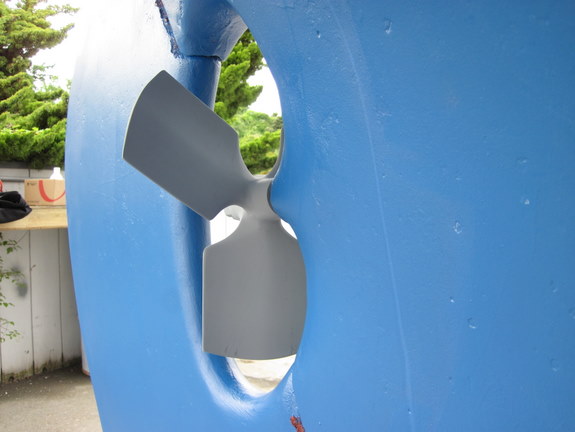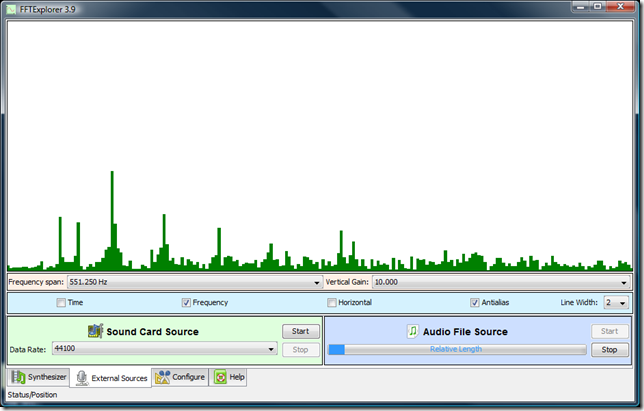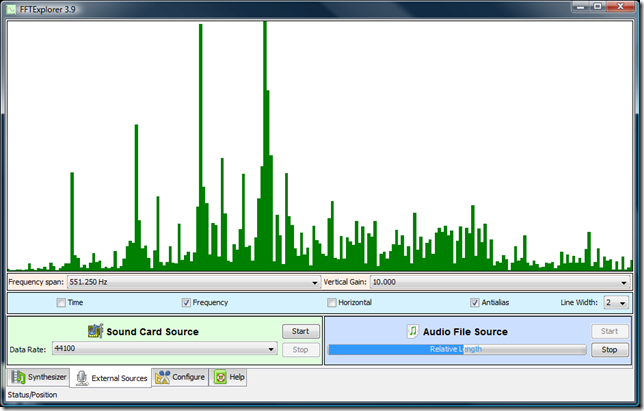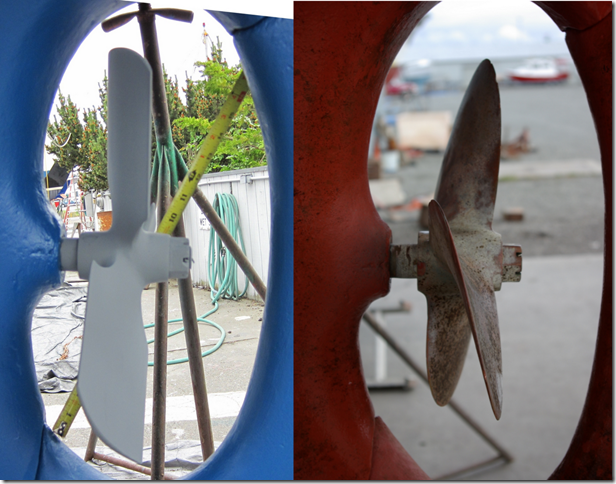Prop Analysis and Replacement – Part II: The Axiom Prop

June 22nd, 2011 | by Van | Published in Maintenance and Repairs, Upgrades
Axiom made the new prop in just under three weeks, and UPS got it here in just five days. What an amazingly flat world. We timed our annual haul out in Port Townsend to match the arrival date for the prop. It installed on the shaft perfectly – we’d been able to provide Axiom with the original drawings (see the info on Jeremy Lines’ CD on the nicholson38.org web site) for the shaft, so they knew exactly how to bore the prop hub.
Underway
The first notable thing, was that the new prop seemed to “bite” the water much better. Putting the transmission into gear immediately starts to move the boat. This is a little unnerving at first but you get used to it. The prop was also quieter at these low RPM.
In reverse, the Axiom propeller lived up to its claims – very little if any prop walk, and lots of power. In fact, it was a bit worrying to be able to back up straight and build up plenty of speed – worry that the rudder would slip to the side and then slam over hard into the rudder stops, but that never happened.
Underway, the noise from the prop was “different”. At lower RPM, it was definitely quieter than the screw. At about 1300 RPM, the prop started to make “swishing” sounds. I think this is just the motion of water past the rudder and deadwood, which we could not hear before because of the loud noise from the screw prop.
At 1800 RPM, the prop moved us along nicely, at about 5.5 – 6.0 knots. The speed vs RPM for the Axiom prop was very similar to that for the screw.
Strange sounds…
As we increased RPM, at about 2200 we started to get really severe noise. Hard to describe – not like the cavitation we got with the screw prop at 2000, which sounded like gravel going through it. Instead, we started to get large, loud vibrations in the hull and associated parts. Very much seemed like the prop was beating the heck out of the deadwood. Several times it sounded to me a bit like the sound when you stick a straw or finger into the blades of a rotating fan. That sound would come and go, lasting just a second or so. Quite unnerving. The noise and vibration basically makes it impossible to motor for long at RPMs higher than about 1800. We were also very worried that the vibrations would damage the transmission – the noise and vibration was that severe.
Over propped again
The max RPM we could get was 2700 RPM at which we were going 7.0 knots. At that point, the noise was very bad (scary bad), and black smoke was coming out of the exhaust. The loud rumbling might have been cavitation, but it was very different to the cavitation of the screw prop (gravel going through the blades). The target RPM at wide open throttle is between 3200 (the continuous duty rating for the 4-108) and 3600 (the max intermittent duty rating). So, this prop appears to be “over propped”. With the 16×12 screw prop, we maxed out at 2600 RPM.
Fast Fourier Transform
A Fast Fourier Transform (aka FFT) is a mathematical method that takes something like a sound wave (say your favorite Led Zeppelin track or prop recording), and breaks it up into its various frequency components. It can tell you how much of the energy in the sound is at a frequency of say, 60Hz. David Gerr suggests using this to study
I took high quality audio recordings with a Zoom H2n Recorder (which I really like) and ran them through an FFT program (FFTExplorer by Paul Lutus, at arachnoid.com, it’s free as long as you don’t whine). I found the best recordings were made with the microphone in contact with a cabinet in the aft cabin.
The data in the first chart, taken at about 1800 engine RPM, shows a large peak at 47Hz, or 1.5 times the engine frequency. This is the sound of the three blades passing the deadwood – a 2:1 reduction ratio and three blades give a factor of 1.5, so eg at 1800 engine RPM (= 30 Hz), the primary prop peak is at 45 Hz. There is also a very tall but very narrow peak at twice this value, showing that the prop is indeed making noise at both the upper and lower sides of the aperture. Alan Watts, at Axiom, told me this might be the case – it had not occurred to me before. Nice to see it in the data.
In between these two peaks is another at 62 Hz which is the engine RPM x 2.
Also of note, there is no significant component at the shaft rotation frequency (15 Hz). This is important because I would expect that component to be large if the shaft is vibrating, for instance due to a loose or poorly fitting bearing, or if the prop were unbalanced.

The next chart is for 2200 RPM. At this point, the noise seemed very loud. The vertical scale is the same in both charts. The first peak is at 56 Hz, the next at 114, then 170, then 226 corresponding to the prop frequency x1, x2, x3, and x4.
It’s very interesting that so much of the energy is in the higher harmonics of the prop frequency. But only up to the 4th harmonic – not the 5th. The 4th harmonic might be related to shock waves from the leading and trailing edges/corners of each blade – that would give you twice the frequency. So the x2 peak would become a x4 peak. But I don’t know where a x3 peak would come from!
Qualitatively, these two plots are very different. It’s as if a new process is occurring. The subjective difference in sound between 1800 and 2200 RPM is dramatic.

What we learn from the FFT data, is that the interaction between the blades of the prop and the deadwood is dominating the sound. That’s a bad sign.
Looking at the design of the Axiom propeller, you can see from the photo below that unlike a screw prop, the blades do not lean backwards from the hub like a screw does. (Yes, we painted the hull blue). This means that the clearance between the blades and the deadwood is much less – in fact, we measured it at about 1.2 inches, which is far less than the recommended 2.5 inches (at least 15% of the prop diameter, per Gerr). This probably explains the excessive noise from the blades passing the deadwood.

At this stage, we contacted Axiom. They had always assured us they would get us a prop that fit or would give us our money back, and they stuck by this promise. (This was a much more pleasant experience than we had with North Sails last fall).
We agreed with them it would be unfortunate if we had to return it and get our money back – and agreed they would make us a second prop. This one would have the blades set further back on the hub. And to correct the over propping, it would have a 15.25 inch diameter with a 19 degree shear.
Next: Part III, where we report on the 2nd replacement Axiom Prop
Previous: Part I, where we report on the analysis